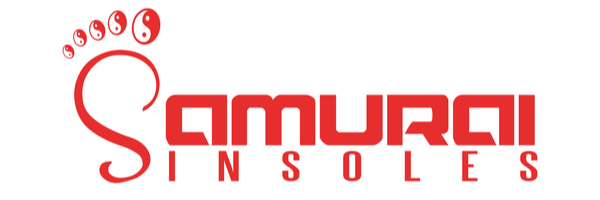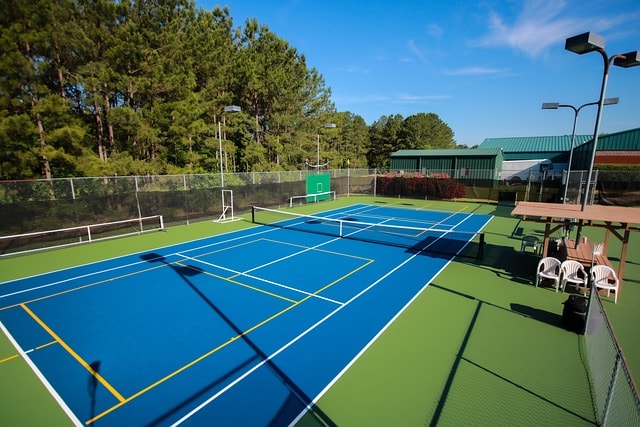Choosing the right shoe inserts isn't about grabbing the first pair you see off the shelf. It’s a bit more personal than that. You need to match the insole's material and how much support it offers to your specific foot shape, any pain you're feeling, and what you do all day.
What works for a marathon runner is going to be completely different from what a construction worker needs. A good insert should cradle your natural arch, absorb the shock of every step, and, most importantly, make your feet feel better.
Finding the Right Support for Your Feet
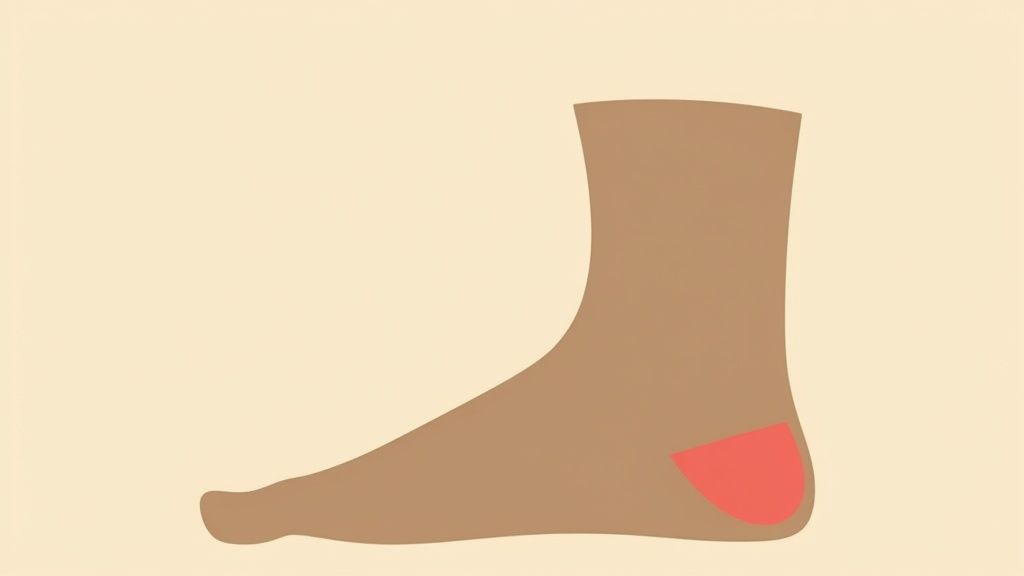
Let’s be honest, nagging foot pain can ruin your day. It can keep you from enjoying a simple walk, let alone your favorite hobbies. The fix isn't just stuffing a flimsy piece of foam into your shoe. It's about finding a tool truly designed for comfort, better performance, and the long-term health of your feet. The right insert can honestly be a game-changer.
Think about someone working a 10-hour retail shift on a hard floor who finally gets relief from throbbing arches. Or imagine a runner who thought plantar fasciitis had them beat, only to come back and set a new personal record. These stories are more common than you'd think, and they all start with moving past the generic insoles that come in most shoes.
Why Your Factory Insoles Fall Short
Those little inserts that come with a new pair of shoes? They're basically just placeholders. They offer a bit of soft cushioning but almost zero real, structural support. This is a huge issue when you consider that up to 75% of adults will deal with serious foot problems at some point, and a lot of that comes from not having proper support.
Those factory liners are made to be easily removed for a good reason—they expect you to replace them with something that actually fits your needs. Whether you have flat feet, super high arches, or pain in a specific spot, a better insert gives your body the foundation it’s been missing. To figure out what you need, it helps to learn what different insoles do. Our detailed guide on arch support insoles is a fantastic place to start.
For a lot of people, the "aha" moment comes when they realize their foot pain—and sometimes even their knee or back pain—isn't just something they have to put up with. It's often a direct result of unsupported feet, which is the exact problem a good shoe insert is designed to fix.
This guide is your practical roadmap. We'll walk you through how to find that perfect match and move from feeling general discomfort to targeted, lasting relief.
Get to Know Your Feet First
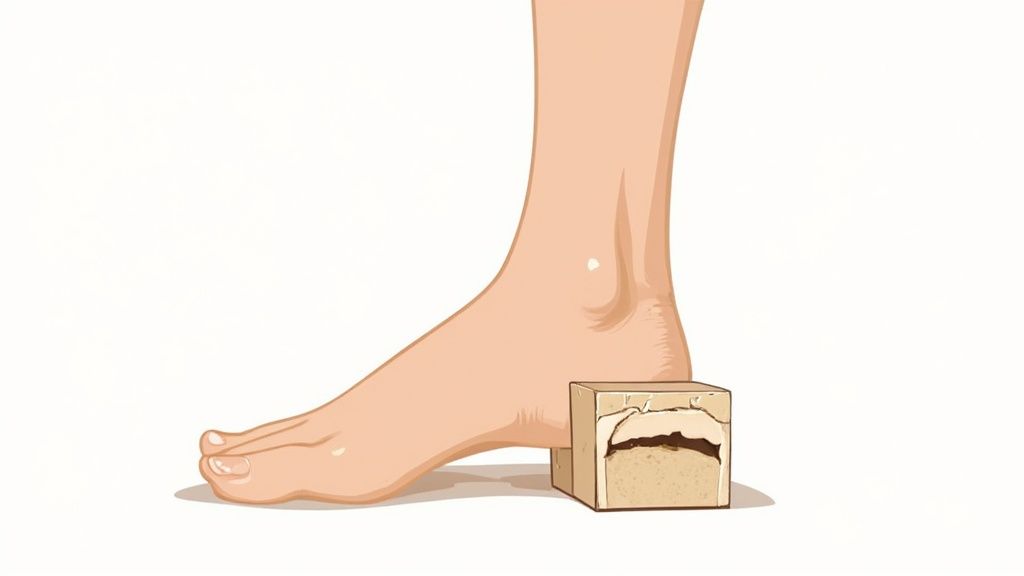
Before you even think about buying a pair of insoles, you need to become a bit of an expert on your own feet. Think of yourself as a detective. Your feet are leaving clues about what they need, and understanding those clues is the only way to solve the case of your discomfort. Otherwise, you’re just taking a shot in the dark.
When you know your foot’s unique profile, you stop being a confused shopper and start being an informed one. It's the difference between guessing and knowing. This isn't about complex medical science; it’s about learning a few key things that will point you directly to the right solution.
The Easiest Way to Find Your Arch Type
Your arch height is one of the most critical pieces of information you can have. It governs how your foot handles impact and distributes your body weight with every single step you take. The good news? You don't need any fancy gear to figure it out. The classic "wet test" is a super simple and surprisingly accurate method you can do right in your bathroom.
Here's how it works:
- Find a shallow pan or baking sheet and pour a thin layer of water into it.
- Get the bottom of one foot completely wet.
- Step firmly onto a piece of cardboard or a dark towel—anything that will show a clear footprint.
- Lift your foot and take a look at the imprint you left behind.
That simple, wet shape tells you almost everything you need to know.
Expert Takeaway: The shape of your footprint is a direct map of how your foot meets the ground. A wide, full print usually means a flatter arch that needs more stability. A skinny, curved print points to a high arch that is starving for cushioning.
What Your Footprint Is Telling You
Okay, let's decode that footprint. What you see will almost certainly fall into one of three main categories, and each one has very different needs for support.
-
Flat Arch (Overpronation): Does your footprint look like a solid block, with the entire bottom of your foot making contact? You likely have flat arches. This often causes overpronation, where your foot rolls too far inward. To counteract this, you'll need insoles with firm, structured arch support to create stability where you lack it.
-
Neutral Arch: If you see a clear curve on the inside of your foot, connecting the heel to the ball, you have a neutral arch. Your foot mechanics are pretty efficient, but that doesn't mean you can't benefit from an insole. A balanced insert with moderate support and cushioning will help prevent fatigue and keep your feet happy.
-
High Arch (Supination): Is your footprint mostly just your heel and the ball of your foot, with a super thin (or even non-existent) line connecting them? That's a classic high arch. This structure often leads to supination, where the foot rolls outward, putting immense pressure on the outer edges of your feet and ankles. You need well-cushioned insoles to absorb that shock.
Getting this right is everything. A staggering 75% of American adults report dealing with foot problems at some point, and knowing your arch type is the absolute first step toward finding relief. Choosing the wrong insole can actually make things worse.
Naming Your Pain
Once you know your arch type, it’s time to get specific about the pain itself. Where, exactly, does it hurt?
Is it a sharp, stabbing pain in your heel, especially when you first get out of bed? That’s the textbook sign of plantar fasciitis. Or maybe the pain is concentrated right under the ball of your foot? That could be metatarsalgia.
Being able to name the pain and its location helps you narrow down your options in a huge way. When you can search for an insole designed for "high arches and plantar fasciitis," you're much closer to finding the perfect match.
For a deeper dive into how to match your pain and arch type to the perfect product, check out our guide on choosing the right insoles.
A Practical Guide to Different Insole Types
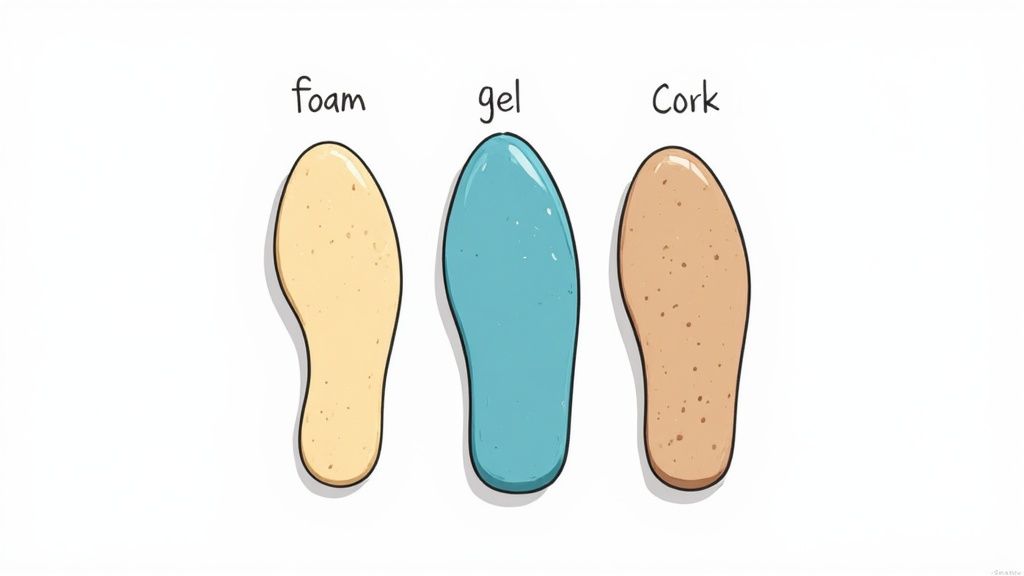
Okay, so you've figured out your foot type and have a good idea of what's causing your discomfort. That’s the hardest part done. Now, we can dive into the world of shoe inserts, which suddenly becomes a lot less confusing.
While the wall of options at the store can look overwhelming, almost every insert falls into one of three main camps. Think of it this way: you wouldn't use a butter knife to chop vegetables. Each type of insole is a tool for a specific job. Let's look at the main players so you can find the right tool for your feet.
Comfort and Cushioning Insoles
These are the most basic inserts you'll find, usually made from soft foam or a squishy gel. Their one and only job is cushioning.
They're perfect for someone who doesn't have a specific structural foot problem but just wants a bit more padding. If you're on your feet all day and feel that general end-of-day soreness, these can provide some relief. They absorb a bit of shock, but that’s about it. Don't expect them to fix issues like collapsing arches or heel pain—they’re a simple comfort upgrade, not a corrective solution.
Supportive Insoles
This is where you'll find real relief for common foot problems. Supportive insoles, often called orthotic inserts, are built differently. They have a firm, structured arch and a deep heel cup designed to stabilize your foot.
These are the heavy lifters for anyone dealing with plantar fasciitis, flat feet, or general arch pain. They do more than just cushion; they provide actual stability. By guiding your foot into a more ideal alignment, they reduce the strain on your tendons and ligaments. If you're dealing with that sharp heel pain, you can learn more about finding the right inserts for plantar fasciitis in our specialized guide.
Key Takeaway: You'll often hear the term motion control used with supportive insoles. This just means the insert helps limit wonky foot movements, like the excessive inward roll of an overpronated foot. A solid arch support is what makes this happen.
Custom Orthotics
These are the top-tier, fully personalized option, prescribed and created by a podiatrist. A medical professional takes a precise mold or a 3D scan of your feet to craft an insert that is literally made for you and you alone.
Custom orthotics are typically reserved for severe foot conditions, major biomechanical problems, or situations where off-the-shelf solutions just haven't worked. That level of customization comes with a hefty price tag, often $200 to $800+, and it isn't always covered by insurance.
Comparing Shoe Insert Types
To make things even clearer, here’s a quick comparison of the main types of shoe inserts. This should help you quickly see which category is the best fit for your needs and budget.
| Insert Type | Best For | Key Feature | Typical Price Range |
|---|---|---|---|
| Comfort Insoles | General foot fatigue, extra cushioning | Soft gel or foam padding | $10 - $30 |
| Supportive Insoles | Plantar fasciitis, flat feet, overpronation | Firm, structured arch support | $30 - $80 |
| Custom Orthotics | Severe or complex foot conditions | Medically prescribed, perfect custom fit | $200 - $800+ |
Ultimately, choosing the right type comes down to being honest about your needs. If you just want a little more softness underfoot, a comfort insole is a good start. But if you’re looking to solve an underlying issue like arch pain or instability, your focus should be on supportive, structured inserts.
Matching Inserts to Your Daily Activities
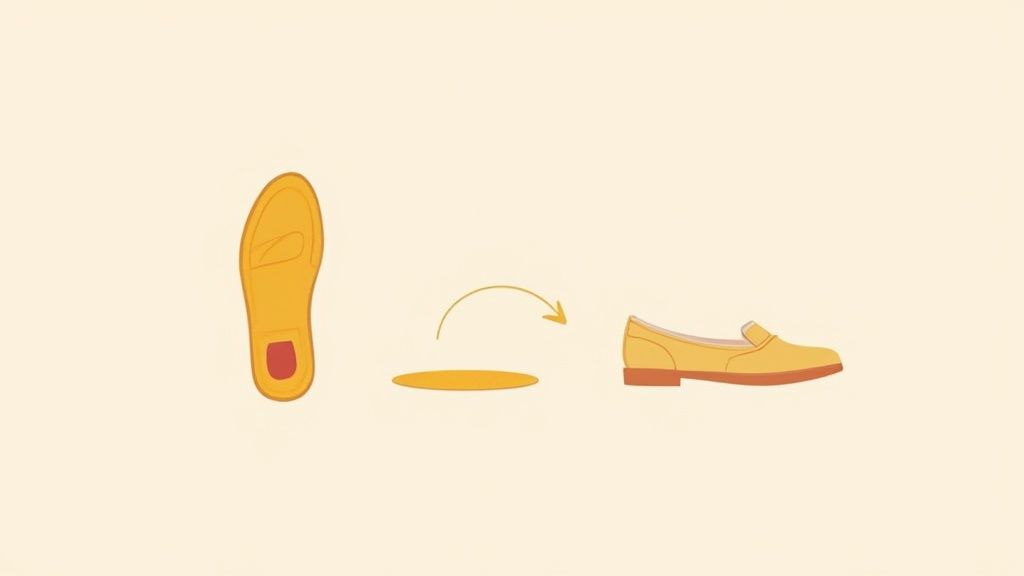
The insert that makes your running shoes feel like you’re on a cloud will probably feel bulky and out of place in your work loafers. It's a classic mistake: buying one "perfect" pair of insoles and trying to swap them between every shoe you own. But the reality is, your lifestyle should be the ultimate guide for the right choice.
Think about it this way—the forces your feet handle during a 5k run are completely different from the pressure they take during an eight-hour shift standing at a cash register. You have to match the insole’s features to what you’re actually doing.
For High-Impact Sports and Activities
When you’re running, jumping, or playing sports, your feet are absorbing an incredible amount of force—often several times your body weight with every step. Cushioning and shock absorption are key, but they have to work hand-in-hand with firm support to keep you from getting hurt.
For these high-energy activities, look for inserts with a few specific features:
- Deep Heel Cups: This design cradles the heel's natural fat pad, which helps it absorb shock more effectively. It also gives you a ton of stability for quick side-to-side movements.
- Responsive Cushioning: Look past basic gel. Materials like advanced polyurethane foams give you that "bounce-back" feeling and return energy, so you feel less fatigued.
- Rigid or Semi-Rigid Arch Support: This is absolutely crucial for keeping your foot aligned when it's under stress. It prevents your arch from collapsing, which is a common cause of issues like plantar fasciitis.
An insert that’s too soft just won't give you the stability you need, but one that’s rock-hard won’t have enough give for those repetitive impacts.
For All-Day Standing and Walking
If your job keeps you on your feet all day, the real enemies are fatigue and constant pressure. Unlike sports, the stress isn't explosive; it's a slow, steady grind. The goal here is less about bounce and more about sustained support and distributing pressure evenly.
For a long workday, you want an insert that prioritizes stability. A semi-rigid shell is great because it supports your arch consistently, keeping your foot muscles from getting overworked and tired. This is where choosing an insert based on your foot’s unique biomechanics really pays off.
Key Insight: Motion control insoles are designed to guide your foot into a more neutral position. Clinical trials have shown they can reduce overpronation in over 80% of cases. That's the kind of targeted support that makes a real difference when you're standing all day.
For Low-Profile Dress and Casual Shoes
Trying to get meaningful support into a pair of snug dress shoes or flats can feel like a lost cause. Those bulky athletic insoles just don't fit, so a lot of people simply give up and live with the discomfort. The secret here is all about the insole's profile and what it’s made of.
You need a slim, low-volume insert that won't make your shoes feel tight. Look for options with a thinner design but a strong, lightweight core, which is often made from durable polymers. These materials can offer serious arch support without the bulk of thick foam.
Market trends show a huge demand for this kind of versatility. In fact, polymer-based and silicone inserts now account for over 50% of materials used, thanks to their blend of durability and low-profile design. It's also interesting to see that about 65% of users aged 45+ are specifically looking for orthotic solutions to manage conditions. You can discover more about these market trends and material choices to understand how the industry is adapting.
Often, a three-quarter length insert or a very thin full-length one designed for dress shoes is the perfect compromise, giving you support without ruining the fit.
When to See a Podiatrist
Off-the-shelf shoe inserts can be a real game-changer for everyday aches and pains. I often recommend them as a great starting point. But, it's just as important to know when they're not enough.
Sometimes, a simple insert just can't tackle the root of the problem. Your body has a way of telling you when it's time to stop the guesswork and get a professional opinion from someone like a podiatrist. Listening to those signals is crucial—ignoring them can turn a small issue into a chronic one.
Signs That You Need Professional Help
Let's say you've been using a good pair of supportive insoles for a few weeks, but that nagging pain in your heel or arch just won't quit. Or maybe it's even getting worse. That's your number one sign. If the pain is persistent and messes with your daily life, it's a clear signal that a generic solution isn't hitting the mark.
You also need to pay close attention to how your feet feel. Any kind of numbness, tingling, or a burning sensation is a major red flag. Those symptoms can point toward nerve issues. For example, it could be Morton's Neuroma, where tissue thickens around a nerve in your foot. An off-the-shelf insert can't fix that; you need a proper diagnosis and a targeted treatment plan.
Finally, some situations are non-negotiable and demand an expert's care from the get-go.
- Diabetes: If you have diabetes, foot health is serious business. Even a small blister can lead to major complications, so never try to self-treat. Always consult your doctor.
- Significant Deformities: We're not talking about minor imperfections. Large, painful bunions, hammertoes, or other major structural issues need a professional's eye.
- Arthritis: While inserts can provide some relief, a podiatrist can create a complete management plan to deal with arthritic pain in your feet, which often involves more than just cushioning.
Seeing a professional isn't admitting defeat. It's taking the right step when you're dealing with a more complex issue. A podiatrist provides a definitive diagnosis—something all the online articles in the world can't give you.
What to Expect with Custom Orthotics
So, what happens if your podiatrist agrees that a store-bought insert isn't going to cut it? The next step is often custom orthotics, which are in a totally different league.
The process starts with a deep dive into how you move. They'll do a full exam, including a gait analysis, which means they'll watch you walk and run to see exactly how your feet and ankles function. It's fascinating to see your own biomechanics in action.
Next, they’ll create a perfect model of your feet. This isn't a simple tracing; they'll either take a physical plaster mold or use a high-tech 3D digital scanner. This blueprint is then used to create a medical-grade device that is built for your feet and your specific needs.
The final piece of the puzzle is the fitting. Your podiatrist will have you try on the orthotics in your own shoes to make sure they're correcting your issue properly and feel right. It's a truly personalized solution for when a one-size-fits-all approach just isn't an option.
Answering Your Questions About New Shoe Inserts
So, you've done the hard work of picking out the right shoe inserts. That's a huge step! But now that you have them in hand, a few new questions might be popping into your head. Getting the best results isn't just about choosing the right pair—it's also about knowing how to use them correctly.
Let's clear up some of the most common things people ask once they bring their new insoles home.
How Long Will My New Inserts Last?
This is probably the number one question I hear, and the honest answer is: it depends. The lifespan of your inserts comes down to two main things—what they’re made of and how much of a beating you give them.
Simple foam or gel insoles are great for a bit of extra cushion, but they don't last forever. If you’re on your feet all day or using them for running, you'll likely need to swap them out every 6 to 9 months. A tell-tale sign is when they start to look compressed and flat, or you notice that old familiar ache starting to return.
On the flip side, a more structured orthotic built from sturdy polymers is a different story. These are designed for the long haul and can easily last anywhere from 1 to 3 years before they start to lose their supportive shape.
Do I Really Need to Break in New Inserts?
Yes, you absolutely do. This is especially true for inserts with firm, structured arch support. You're essentially retraining your feet, and just like any new exercise, your body needs time to adapt to this new, healthier alignment.
Here’s a simple plan I recommend:
- Start by wearing them for just 1-2 hours on the first day.
- Gradually add another hour of wear time each day after that.
It's normal to feel a bit of "awareness" or mild discomfort as your muscles adjust, but you should never feel any sharp or lasting pain. If you do, that's your body's signal to take them out and give your feet a break.
My Two Cents: Don't rush the break-in period. Trying to wear them all day right out of the box is a common mistake that can cause more soreness, not less. Be patient and let your feet ease into the new support.
Is It Okay to Move Inserts Between Different Shoes?
You can, but I usually advise against it for the best results. For an insert to do its job properly, it has to fit perfectly inside the shoe—no sliding around, no bunching up.
Think about it: an insert designed for a wide, high-volume running shoe just isn't going to sit right inside a narrow leather loafer. Forcing it in can create weird pressure points and completely negate the benefits.
If you want consistent relief, your best bet is to get dedicated inserts for the shoes you spend the most time in. This way, you get a perfect fit and reliable support every single time you put them on, without the hassle of swapping them back and forth.
Ready to stop guessing and give your feet the support they've been begging for? Samurai Insoles are specifically designed to tackle common issues like overpronation and plantar fasciitis. See for yourself with our 60-day trial. Find your perfect fit at SamuraiInsoles.com and take the first step toward a more comfortable day.
